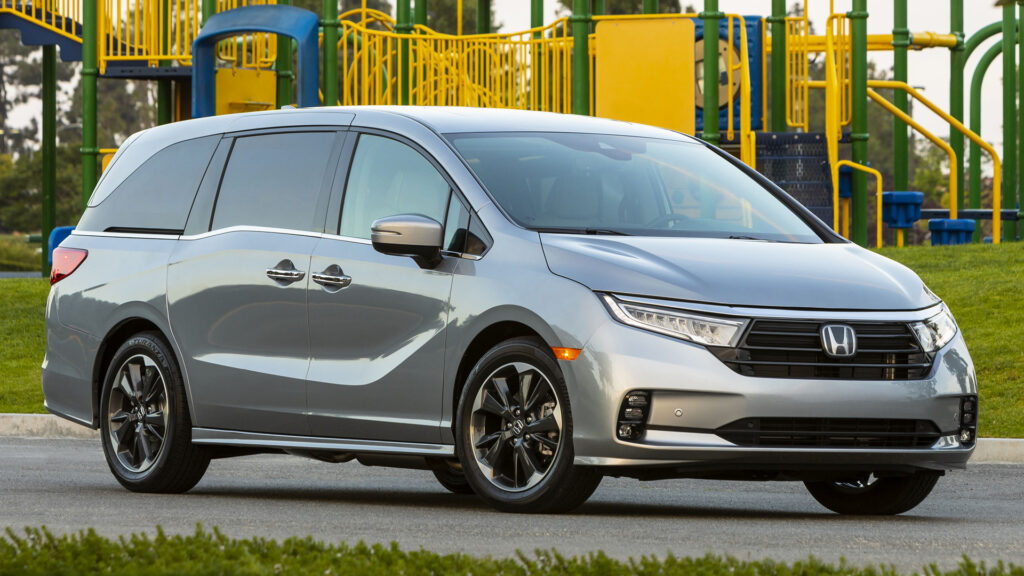In this comprehensive guide, we’ll delve into the intricacies of tire pressure for various Honda Odyssey generations and trim levels. Additionally, we’ll explore the mystery of resetting the low tire pressure light. So buckle up, fellow Honda Odyssey enthusiasts, as we embark on this tire pressure odyssey!
The Importance of Tire Pressure
Proper tire pressure is a vital aspect of your Honda Odyssey’s performance, handling, and safety. Incorrectly inflated tires can negatively impact fuel efficiency, tire wear, braking, and overall stability on the road. Therefore, it’s essential to monitor and maintain the recommended tire pressure for your specific Honda Odyssey model.
Tire Pressure for Different Honda Odyssey Generations
Let’s start our journey by examining the recommended tire pressures for different generations of the Honda Odyssey. Here’s a handy table to guide you:
1st Generation (1995-1998)
| Year | Recommended Tire Pressure (Front/Rear) |
|---|---|
| 1995 | 32 psi / 32 psi |
| 1996 | 32 psi / 32 psi |
| 1997 | 32 psi / 32 psi |
| 1998 | 32 psi / 32 psi |
2nd Generation (1999-2004)
| Year | Recommended Tire Pressure (Front/Rear) |
|---|---|
| 1999 | 33 psi / 33 psi |
| 2000 | 33 psi / 33 psi |
| 2001 | 33 psi / 33 psi |
| 2002 | 33 psi / 33 psi |
| 2003 | 33 psi / 33 psi |
| 2004 | 33 psi / 33 psi |
3rd Generation (2005-2010)
| Year | Recommended Tire Pressure (Front/Rear) |
|---|---|
| 2005 | 35 psi / 35 psi |
| 2006 | 35 psi / 35 psi |
| 2007 | 35 psi / 35 psi |
| 2008 | 35 psi / 35 psi |
| 2009 | 35 psi / 35 psi |
| 2010 | 35 psi / 35 psi |
4th Generation (2011-2017)
| Year | Recommended Tire Pressure (Front/Rear) |
|---|---|
| 2011 | 36 psi / 36 psi |
| 2012 | 36 psi / 36 psi |
| 2013 | 36 psi / 36 psi |
| 2014 | 36 psi / 36 psi |
| 2015 | 36 psi / 36 psi |
| 2016 | 36 psi / 36 psi |
| 2017 | 36 psi / 36 psi |
5th Generation (2018-Present)
| Year | Recommended Tire Pressure (Front/Rear) |
|---|---|
| 2018 | 35 psi / 35 psi |
| 2019 | 35 psi / 35 psi |
| 2020 | 35 psi / 35 psi |
| 2021 | 35 psi / 35 psi |
| 2022 | 35 psi / 35 psi |
| 2023 | 35 psi / 35 psi |
Please note that these recommended tire pressures are general guidelines. Always refer to your vehicle’s owner’s manual or the sticker located on the driver’s side door jamb for the precise recommended pressures for your specific trim level.
Tire Pressure for Different Honda Odyssey Trim Levels
Now, let’s deep-dive into the recommended tire pressures based on various Honda Odyssey trim levels. Refer to this informative table for the specific numbers:
| Trim Level | Recommended Tire Pressure (Front/Rear) |
|---|---|
| LX, EX, EX-L | 35 psi / 35 psi |
| Touring, Elite | 36 psi / 36 psi |
| Touring Elite SE | 35 psi / 35 psi |
It’s crucial to note that these recommendations may vary slightly depending on factors such as tire size, load capacity, and driving conditions. Always consult your owner’s manual for the most accurate and up-to-date information for your particular trim level.

Maintaining the Right Tire Pressure
Now that we understand the importance of maintaining the right tire pressure and the factors that influence it, let’s explore how you can ensure your Honda Odyssey’s tires are properly inflated.
1. Regular Tire Pressure Checks
Regularly checking your Honda Odyssey’s tire pressure is crucial for maintaining optimal performance and safety. It is recommended to check the tire pressure at least once a month and before embarking on long trips. Use a reliable tire pressure gauge to measure the pressure accurately.
2. Adjusting Tire Pressure
If the tire pressure is below the recommended level, you should add air to reach the appropriate pressure. On the other hand, if the tire pressure is too high, release air until it matches the manufacturer’s guidelines. Always remember to check the tire pressure when the tires are cold, as driving heats up the tires and increases the pressure, potentially leading to inaccurate readings.
3. Tire Rotation and Alignment
Regular tire rotation and alignment are essential for maintaining even tire wear and optimal handling. Consult your Honda Odyssey’s owner’s manual for the recommended tire rotation intervals and alignment specifications. Properly aligned and evenly worn tires contribute to better fuel efficiency and a smoother driving experience.
4. Professional Inspection
Periodically, it is recommended to have your Honda Odyssey’s tires professionally inspected by a qualified technician. They can assess the overall tire condition, check for any signs of damage or uneven wear, and provide valuable recommendations to ensure your tires are in top shape.
FAQs (Frequently Asked Questions)
1. What happens if I drive with incorrect tire pressure?
Driving with incorrect tire pressure can have various negative consequences. Underinflated tires can lead to reduced fuel efficiency, increased tire wear, decreased handling capabilities, and an increased risk of blowouts. Overinflated tires, on the other hand, may result in a harsh ride, reduced traction, and uneven tire wear. It is essential to maintain the right tire pressure to avoid compromising your Honda Odyssey’s performance and safety.
2. Can I use the same tire pressure for all four tires?
While it may seem convenient to use the same tire pressure for all four tires, it is not always the best approach. Different factors, such as load capacity and driving conditions, can require adjustments to the tire pressure. It is crucial to refer to your Honda Odyssey’s owner’s manual for the recommended tire pressure for each tire, considering the specific circumstances.
3. Can I rely on the tire pressure monitoring system (TPMS)?
The tire pressure monitoring system (TPMS) in your Honda Odyssey is designed to alert you when the tire pressure is significantly low. However, it is not a substitute for regular manual tire pressure checks. The TPMS provides a warning when the pressure has reached a certain threshold but may not detect slight variations or gradual pressure loss. Therefore, it is essential to manually check the tire pressure regularly.
4. How can I find the correct tire pressure for my Honda Odyssey model?
To find the correct tire pressure for your Honda Odyssey model, you can refer to the owner’s manual provided with your vehicle. Additionally, the recommended tire pressure is often displayed on a sticker located on the driver’s side door jamb or inside the fuel filler door. If you are uncertain or have any questions, contacting a trusted Honda dealership or professional technician can provide you with accurate guidance.
5. Can incorrect tire pressure affect my Honda Odyssey’s fuel efficiency?
Yes, incorrect tire pressure can have a direct impact on your Honda Odyssey’s fuel efficiency. Underinflated tires create more rolling resistance, requiring the engine to work harder and consume more fuel. On the other hand, overinflated tires can cause reduced traction and uneven tire wear, also affecting fuel efficiency. By maintaining the right tire pressure, you can optimize your vehicle’s fuel economy.
6. What should I do if I encounter a tire pressure warning light?
If the tire pressure warning light illuminates on your Honda Odyssey’s dashboard, it indicates that one or more tires have low pressure. As soon as it is safe to do so, find a suitable location to stop and manually check the tire pressure using a gauge. Adjust the pressure accordingly, referring to the recommended levels. If you are unsure or need assistance, contact a professional technician or a Honda dealership.
Resetting the Low Tire Pressure Light
Ah, the dreaded low tire pressure light! If it flickers on your Honda Odyssey’s dashboard, fear not; we have the solution. To reset the low tire pressure light, follow these simple steps:
- Ensure all tires are properly inflated to the recommended pressures.
- Turn the ignition switch to the ON position (do not start the engine).
- Locate the reset button (usually located near the steering column).
- Press and hold the reset button until the low tire pressure light blinks twice.
- Release the reset button.
Voila! The low tire pressure light should be reset, and you can continue your journey with peace of mind.
Conclusion
Maintaining the correct tire pressure is not only a matter of safety but also a means to optimize your Honda Odyssey’s performance. By adhering to the recommended tire pressures for your specific Honda Odyssey generation and trim level, you’ll ensure a smooth, fuel-efficient, and safe driving experience. Don’t forget to reset the low tire pressure light using the simple steps provided.
So go ahead, fellow Honda Odyssey adventurers, and conquer the roads with the power of perfect tire inflation. Happy driving!
